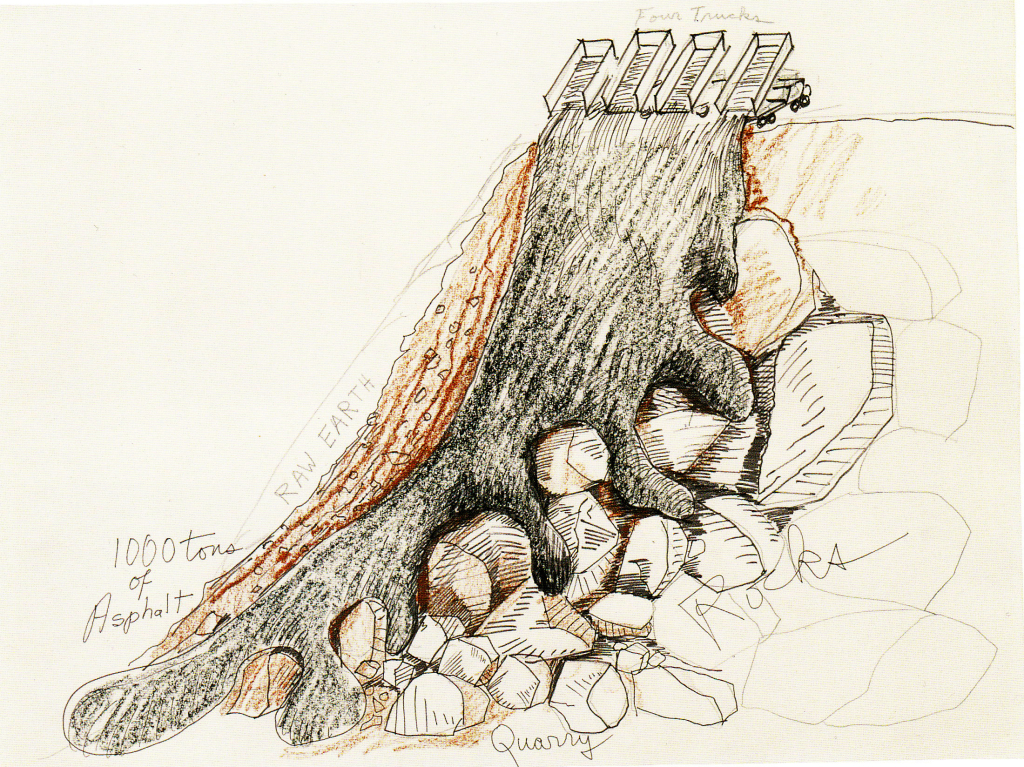By drawing a diagram, a ground plan of a house, a street plan to the location of a site, or a topographic map, one draws a “logical two dimensional picture.” A “logical picture” differs from a natural or realistic picture in that it rarely looks like the thing it stands for. It is a two dimensional analogy or metaphor – A is Z.
This is how Robert Smithson described the concept or dialectic of “site” and “non-site”.
Site is a realistic view or picture, and an abstract, or “logical picture” stands for the non-site.
Land-art radically changed the idea of landscape and broke the limits of sculptural practice. It is a form of sculpture that is made using rock, stone, or mud that comes directly from the earth and built into the earth, paving the way for a novel idea of landscape. Within this movement, Robert Smithson’s view of (devastated industrial) landscape as art, transformed the notion of landscape in relation to humans, and introduced for the first time the “anthropocene” as a model for contemporary artistic, architectural and philosophical thinking. Smithson thought that the arts could be economically and politically integrated into society by reclaiming land in terms of earth art. This could be achieved by working with mining companies to reclaim a devastated open pit as an earth work. With Broken Circle-Spiral Hill in 1971, made near Emmen in Holland, Smithson realized his desire to transform a mined site, in this case a sand pit, into a work of art. His desire that art be a necessary part of society was fulfilled when the people of Emmen voted to preserve and maintain the artwork after its completion in a quarry nearby.
This course, Time Crystals, Rock, Stone and Mud, will introduce students to Smithson’s ideas of ‘site’ and ‘non-site’, as well as his understanding of time through his exploration of crystals and science fiction. Students will reflect on and interpret (these) processes through which art visually reflects accumulation and extraction. We will ask how a non-site becomes a site through architecture as concretization, as a spatial practice. Smithson’s ideas will function as a mode of thinking in relation to art and exhibition architecture, that will form the basis for different forms of collaborative work. Through the coalescence of physical exploration we will look for diverse spatial strategies.
In Time Crystals, Rock, Stone and Mud we will read science fiction, and investigate crystallography, material history and geological time. We will engage with ideas of the Anthropocene, the non-human time-scales and understand how to privilege human world relations. In addition, the course is comprised of site-based fieldwork and research that will enable us to dive into contemporary art and practice: we will go on an excursion to Steindorf am Ossiacher See, where we will observe the landscape and collect stones. Following Smithson’s dialectic of site and non-site, and our findings from the excursion, students will engage with exhibition design, utilizing space, scale, proportion, color, type, and storytelling in support of their conceptual work. In this sense, design processes are used to answer curatorial questions, and with positions students develop will shape an exhibition as an integral part of the module. Upon completion of this module, students will be able to conceptualize and follow through with cross-disciplinary research. They will deepen their knowledge of curatorial and exhibition design processes, and will be able to translate this knowledge, discussion and selective processes of the curatorial into an exhibition.
The introduction to the Robert Smithson's work will be held by Dr. Branko Dimitrijević between 18-28 October. Dimitrijević is a curator, writer, and Professor of History and Theory of Art at the College of Art and Design in Belgrade. His most recent research focuses on the contemporary relevance of Robert Smithson’s “earthworks” and the dialectic within his concept of the “site” and the “non-site”. The seminars will take place on 18, 21, 25 and 28 October at usual times. The public lecture takes place on 20 October at 17:00 in Halle.
Excursion: 21.-25.11.2022 - Domenig Steinhaus and surrounding areas.
